Thorny Skate
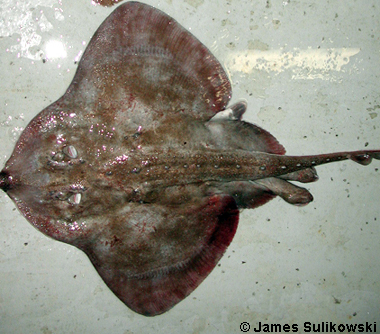
Amblyraja radiata
These cool-water skates have rounded diamond shaped pectoral disks with stout tails, usually muddy brown on top, and white underneath. They are named for the scattered thorny denticles along their spines, edges of pectoral fins, and tails, interspersed with smaller ‘prickles’. These bottom-dwellers prefer brackish or salt water where they eat crustaceans and bony fish, and grow to between 28 and 39 across, depending on the region they live in. Skates are considered harmless to humans because they don’t have the venomous spine that rays have.
Order: Rajiformes
Family: Rajidae
Genus: Amblyraja
Species: radiata
Common Names
English language common names include maiden ray, miller, starry ray, starry skate, thornback, thorny back, and thorny skate. Other common names include agdlernak (Inuktitut), escrita (Spanish), klorocka (Swedish), klorokke (Norwegian), kloskate (Norwegian), kollivsiuternak (Inuktitut), kynsirausku (Finnish), qarlêk (Inuktitut),raia-repregada (Portuguese), raie épineuse (French), raie radiée (French), raie radiée épineuse (French), raja promienista (Polish), raya radiante (Spanish), sternrochen (German), sterrog (Dutch), tærbe (Danish), taralikisâ (Inuktitut), tindaskata (icelandic), tindaskøta (Faroese), vatos spinos (Rumanian), and zvezdchatyi skat (Russian).
Importance to Humans
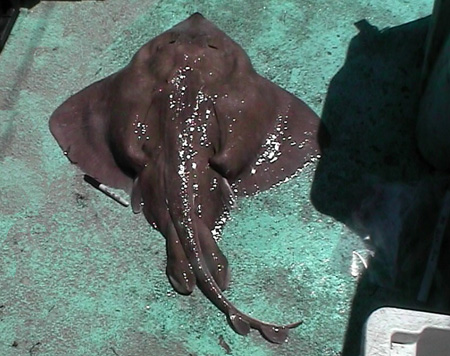
Historically, this species has not been commercially important. However, since A. radiata meets the minimum 1 1/4 pound (0.5 kg)-cut pectoral fin size sought by processors, there has been a recent increase in the market for thorny skate wings. There is potential for over-exploitation since they have low levels of reproduction and mature relatively late, like most elasmobranchs. For example, under laboratory studies, the development period of the embryos, under temperatures of 32°F to 49°F (-0.3°C to 9.5°C), is 2 to 2.5 years.
Danger to Humans
There is little danger associated with the thorny skate. Unlike most stingrays, skates do not have venomous spines. Skates do have thorns that might cause injury to a person if stepped on or picked up.
Conservation Status
Due to an increasing commercial importance, declines in biomass levels, and a paucity of specific biological information, commercial harvests of thorny skates in the U.S. portion of the western north Atlantic Ocean are now prohibited. It has recently been added to the World Conservation Union (IUCN) Redlist and is considered in immediate threat of becoming an endangered species.
> Check the status of the thorny skate at the IUCN website.
Geographical Distribution
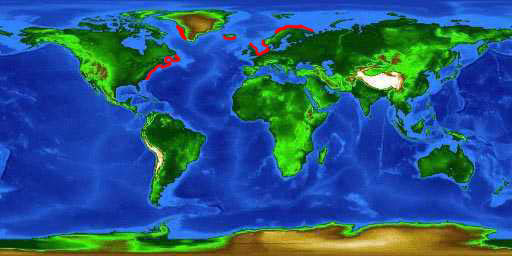
The thorny skate can be found in the eastern and western Atlantic Ocean. In the eastern Atlantic, they range from Svalbarg, Greenland, and Iceland to the English Channel, including the northern part of the North Sea and the western part of the Baltic Sea. In the western Atlantic, they range from Greenland and Canada (Hudson Bay) to South Carolina, USA.
Habitat
The thorny skate is found in marine and brackish waters. This species is a bottom-dweller that is typically found on a variety of substrates including sand, broken shells, gravel, pebbles, and soft mud. These skates inhabit depths ranging from 65.6 to 3,280.8 ft (20-1,000 m). They are cool water fish that live in waters ranging from 30°F to 57°F (-1.3°C to 14°C), yet they seem to prefer 36°F to 41°F (2°C to 5°C). Thorny skates can tolerate salinity’s ranging from 31.2 to 35.3 parts per thousand (ppt), but preferred 32-34.5 ppt. There seems to be evidence that thorny skates can make small seasonal migrations but they generally remain in a defined home range.
Biology
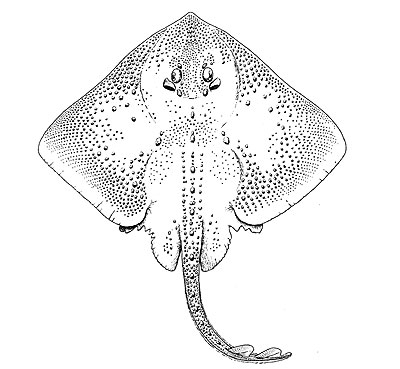
Distinctive Features
This species is distinguished from other skates found in the north Atlantic Ocean by the large thorns that run along the midline of the back from the nape to the first dorsal fin. Another important feature is that the tail has a maximum of 10 large thorns. Two to three large thorns are also found on the shoulders. The snout of the thorny skate is blunt at the tip and the margins bulge a little just behind the eyes.
The pectoral fins are not as broadly rounded along the outer corners when compared to the little skate or the big skate. The dorsal fins can sometimes be joined at the base while other times they are separated by a short space. Sexually mature males have conspicuously strong claspers that reach about halfway down the tail. While young, the length of the tail is 1.1-1.2 times as large as the length of the body from cloaca to snout. The tail length decreases to about 0.9-1.1 times for half-grown and adult thorny skates.
Coloration
The dorsal surface is brown that looks either uniform or partially clouded and can have darker spots. Smaller specimens tend to have more definitive spotting than those of older ones. Occasionally, there are white spots beside each eye, one on each side located beside the nape. These white spots can also be found on each side on the posterior part of the disc. The ventral surface is white that sometimes has blotches that are sooty or brownish.
Dentition
The teeth of the thorny skate consist of about 36 to 46 series of teeth with round bases on each jaw plate. The females and young males have teeth with low cusps that are worn almost smooth in the older rows. Mature males seem to have slightly sharper teeth that tend to be more widely spaced.
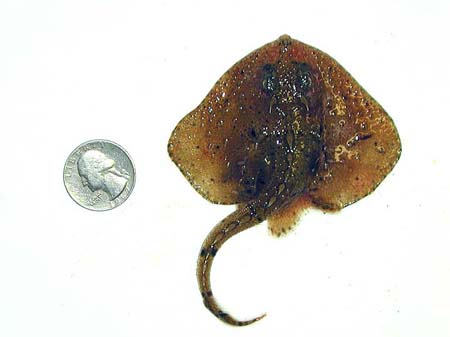
Denticles
The shapes of the thorns are very distinct with those found on the pectorals being star-shaped at the base and those along the midline being more oval. There are a few prominent thorns found on the dorsal surface. There is one thorn close in front of each eye, one on the inner posterior margin of the orbit, one close to the inner end of the spiracle, and two to three on each shoulder. Smaller thorns (sometimes called prickles) are found on the snout, between the orbits, on the shoulders, on the dorsal fins, and the tail. Sometimes prickles can be found on the skin above the eyes, the caudal membrane, and the pelvic fins.
The ventral surface is smooth except for some prickles on the snout. As females mature sexually, they become increasingly thornier with increasing prickles between the thorns. Males, on the other hand, lose most of the thorns on the pectoral fins except along the anterior margins. Typically for adult males, the outer corners of the pectoral fins have two rows of hooked, erectile thorns.
Size, Age, and Growth
In American waters, the typical hatchling size is about 4 inches (10cm) in total length. Along with this broad geographic range, marked differences in size exist for specimens captured in different regions of the Atlantic Ocean. For example, the thorny skate reaches total lengths of over 39 inches (100 cm) in the Gulf of Maine, while specimens captured off the Labrador coast do not reach total lengths > 28 inches (72 cm).
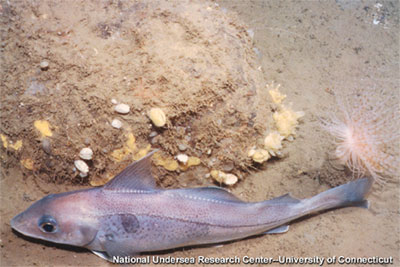
Food Habits
The thorny skate feeds on crustaceans, bony fish, and polychaete worms. Some representatives of these include crabs, shrimp, anemones, eel, finfish, cod, haddock, redfish, and herring.
Reproduction
The thorny skates are oviparous (egg layers). Very little is known about the reproductive biology of this species. The only detailed study was conducted in the Gulf of Maine where thorny skates were found to be reproductively active year round. There is distinct pairing with embrace between the male and female. The ovaries of the female are functional on both sides but in some cases, the right seems to be more productive. The number of developing eggs in the female has ranged from 2 to 88.
Once the eggs are mature and released from the ovaries, they get fertilized in the upper part of the oviduct, and get enclosed with yolk and albumen in a capsule formed by the shell gland. These capsules vary widely in size and are believed to be associated with parental body size. The capsules are light brown and have the characteristic horns on the four corners. Typically, there is only one fertilized egg found in a single capsule. These capsules are flat on one side and convex on the other. The female will often deposit eggs in sandy or muddy flats.
The gestation period is unknown for this species. When the young hatch from the capsules, they are fully formed and are similar in appearance to adult specimens.
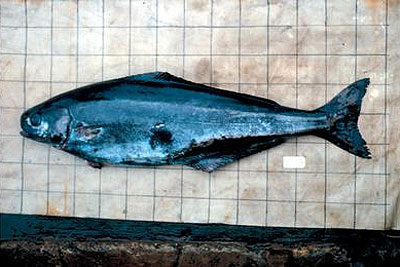
Predators
Predation on the thorny skate has not been well documented. It is suspected that gray seals prey on the adults. Egg capsules have been subject to predation by halibut, goosefish, Greenland sharks, and predatory gastropods.
Parasites
The thorny skate is plagued by a variety of parasites that are found on the skin, in the intestinal tract, and in body cavities. Protozoan parasites include Haemogregarina delagei, Trichodina oviducti, and Trypanosoma rajae. They are parasitized by generalized species of Monogenea. Cestode parasites includeAcanthobothrium coronatum, Anthobothrium cornucopia, A. variabile, Echeneibothrium variabile, Echinobothrium raji, Grillotia sp., Phyllobothrium dagnallium, Phyllobothrium sp., Scyphophyllideum giganteum, and Trilocularia acanthiae-vulgaris. Nematode parasites include Anisakis sp. larva,Contracaecum sp., Phocanema sp. larva, Pseudanisakis tricupola, and Thynnascaris adunca. Copepod parasites include Dendraptra cameroni, Eudactylina corrugata, Lernaeopodina longimana, andSchistobrachia ramose. Other parasites found include Micropharynx parasitica (Turbellaria), Pseudacanthocotyla verrilli (Monogenea), and Otodistomum cestoides (Trematoda).
Taxonomy
The thorny skate was originally named Raja radiata (Donovan, 1808). This name was changed to the currently valid name Amblyraja radiata that same year. The genus name is from the Greek “amblys” meaning blunt or dull and the Latin “raja” meaning stingray. Junior synonyms include Raia americana (DeKay, 1842) and Raia scabrata (Garman, 1913).
Prepared by: Kimberly Kittle